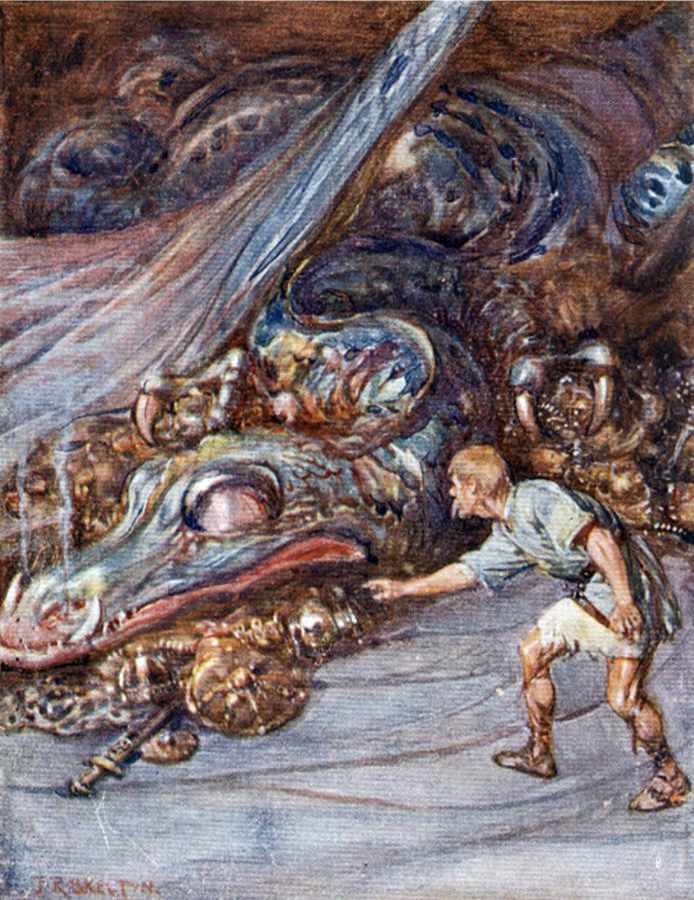The final act of the Anglo-Saxon poem Beowulf includes Beowulf’s fight with a dragon, the third monster he encounters in the epic. On his return from Heorot, where he killed Grendel and Grendel’s mother, Beowulf becomes king of the Geats and rules wisely for fifty years until a slave awakens and angers a dragon by stealing a jewelled cup from its lair. When the angry dragon mercilessly burns the Geats’ homes and lands, Beowulf decides to fight and kill the monster personally. He and his thanes climb to the dragon’s lair where, upon seeing the beast, the thanes flee in terror, leaving only Wiglaf to battle at Beowulf’s side. When the dragon wounds Beowulf fatally, Wiglaf attacks it with his sword, and Beowulf kills it with his dagger. This depiction indicates the growing importance and stabilization of the modern concept of the dragon within European mythology. Beowulf is the first piece of English literature to present a dragonslayer. Although the Beowulf dragon exhibits many existing motifs common to Germanic tradition, the Beowulf poet was the first to combine features and present a distinctive fire-breathing dragon. The Beowulf dragon was adapted for Middle-earth in J. R. R. Tolkien’s The Hobbit (1937), one of the forerunners of modern high fantasy. The dragon fight, near the end of the poem, is foreshadowed in earlier scenes. The fight with the dragon symbolizes Beowulf’s stand against evil and destruction, and, as the hero, he knows that failure will bring destruction to his people after many years of peace. The dragon itself acts as a mock “gold-king”; one who sees attacking Beowulf’s kingdom as suitable retribution for the theft of just a single cup. The scene is structured in thirds, ending with the deaths of the dragon and Beowulf.
| Alias Dragon |
| Real Names/Alt Names Unknown |
| Characteristics Villain, Literary Characters, Reptile, Medieval Age, Scandinavian |
| Creators/Key Contributors Unknown |
| First Appearance Beowulf (Old English epic poem) |
| First Publisher ○ |
| Appearance List Literature: Beowulf (Old English epic poem, written ~975–1025 CE), Beowulf by Francis Barton Gummere (1910) [Internet Archive], Beowulf: An Anglo-Saxon Epic Poem (Project Gutenberg), Bulfinch’s Mythology by Thomas Bulfinch, et. al. Comics: Conquest #1 (Famous Funnies): The tale of Beowulf, Hercules (Charlton). |
| Sample Read The story of Beowulf: translated from Anglo-Saxon into modern English prose [Internet Archive] |
| Description The final act of the Anglo-Saxon poem Beowulf includes Beowulf’s fight with a dragon, the third monster he encounters in the epic. On his return from Heorot, where he killed Grendel and Grendel’s mother, Beowulf becomes king of the Geats and rules wisely for fifty years until a slave awakens and angers a dragon by stealing a jewelled cup from its lair. When the angry dragon mercilessly burns the Geats’ homes and lands, Beowulf decides to fight and kill the monster personally. He and his thanes climb to the dragon’s lair where, upon seeing the beast, the thanes flee in terror, leaving only Wiglaf to battle at Beowulf’s side. When the dragon wounds Beowulf fatally, Wiglaf attacks it with his sword, and Beowulf kills it with his dagger. This depiction indicates the growing importance and stabilization of the modern concept of the dragon within European mythology. Beowulf is the first piece of English literature to present a dragonslayer. Although the Beowulf dragon exhibits many existing motifs common to Germanic tradition, the Beowulf poet was the first to combine features and present a distinctive fire-breathing dragon. The Beowulf dragon was adapted for Middle-earth in J. R. R. Tolkien’s The Hobbit (1937), one of the forerunners of modern high fantasy. The dragon fight, near the end of the poem, is foreshadowed in earlier scenes. The fight with the dragon symbolizes Beowulf’s stand against evil and destruction, and, as the hero, he knows that failure will bring destruction to his people after many years of peace. The dragon itself acts as a mock “gold-king”; one who sees attacking Beowulf’s kingdom as suitable retribution for the theft of just a single cup. The scene is structured in thirds, ending with the deaths of the dragon and Beowulf. |
| Source The dragon (Beowulf) – Wikipedia |

